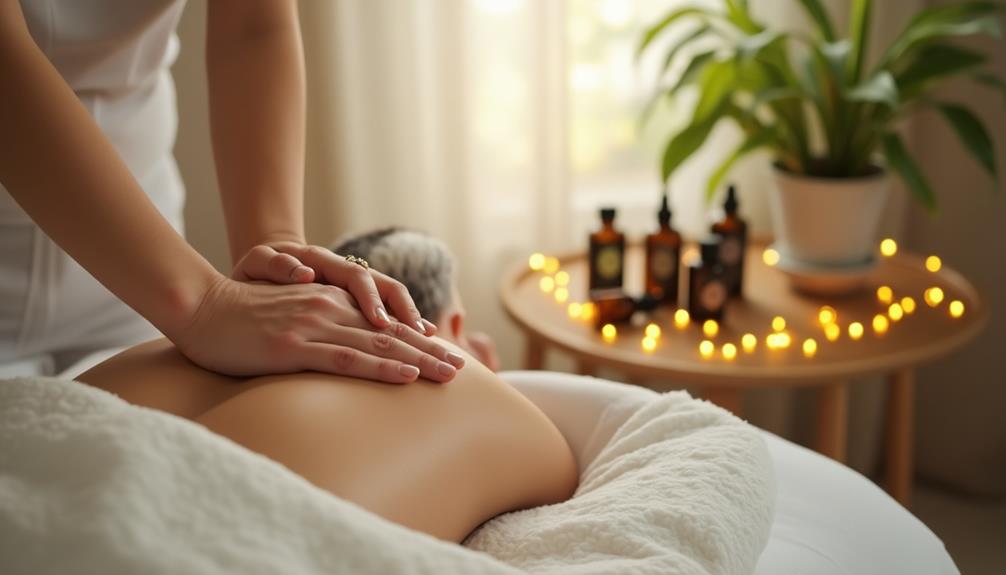To perform effective recovery massage techniques at home, start by choosing a quiet space and gathering tools like massage oil, a foam roller, and massage balls. Apply gentle pressure with your fingers and palms, focusing on tight areas using circular motions. Target specific muscle groups—knead your neck, press your lower back, and stretch your hamstrings. Incorporate necessary oils for added benefits, and remember to breathe deeply to enhance relaxation. After your session, stay hydrated and consider gentle stretching. Consistency is crucial for effective recovery, and there's much more to explore to optimize your self-massage experience.
Core Insights
- Set up a quiet, comfortable space with dim lighting and soothing music to enhance relaxation during your massage.
- Use massage oil to reduce friction and apply gentle pressure to tight muscle areas with your fingers and palms.
- Incorporate tools like a foam roller and massage balls to target specific muscle groups and release tension effectively.
- Focus on deep breathing to promote relaxation, visualizing tension melting away with each exhale throughout the massage.
- Stay hydrated post-massage, rest, and consider gentle stretching to maintain flexibility and maximize recovery benefits.
Understanding Recovery Massage

Recovery massage is a powerful tool for enhancing your body's healing process after physical activity. It helps reduce muscle soreness, improves circulation, and promotes relaxation. By focusing on key muscle groups, recovery massage can alleviate tension, making it easier for your body to recover. Herbal supplements can complement massage techniques, providing additional support for muscle recovery and reducing inflammation.
Understanding how to apply recovery massage techniques is essential. Start by identifying sore areas and gently kneading them. Use long strokes for larger muscle groups and circular motions for smaller areas. Remember to adjust pressure based on your comfort level; it shouldn't be painful. Incorporating breathing techniques can further enhance relaxation. Regularly practicing these techniques not only aids recovery but also helps maintain your overall well-being. With a little practice, you can effectively support your body's healing journey.
Essential Tools and Supplies

| Tool/Supply | Purpose | Tips |
|---|---|---|
| Massage Oil | Reduces friction | Choose natural options |
| Foam Roller | Releases muscle tension | Use on sore areas |
| Massage Balls | Targets trigger points | Roll slowly for best results |
With these tools, you can effectively target sore muscles and improve circulation. Don't forget to set aside some time for yourself to truly benefit from your recovery massage. Enjoy the process, and remember, consistency is key!
Preparing Your Space

To fully enjoy your massage routine, you should consistently prepare your space for relaxation and comfort. Start by choosing a quiet area in your home, away from distractions. Dim the lights or use candles to create a soothing ambiance. You might want to play soft music or nature sounds to enhance your relaxation.
Next, confirm the temperature is comfortable—neither too hot nor too cold. Lay out a soft mat or blanket on the floor, or use your bed if it's more comfortable. Keep your essential tools nearby, so you don't have to interrupt your session. Finally, consider using aromatherapy with essential oils to create an inviting atmosphere. With these steps, you'll set the perfect space for your recovery massage.
Techniques for Self-Massage
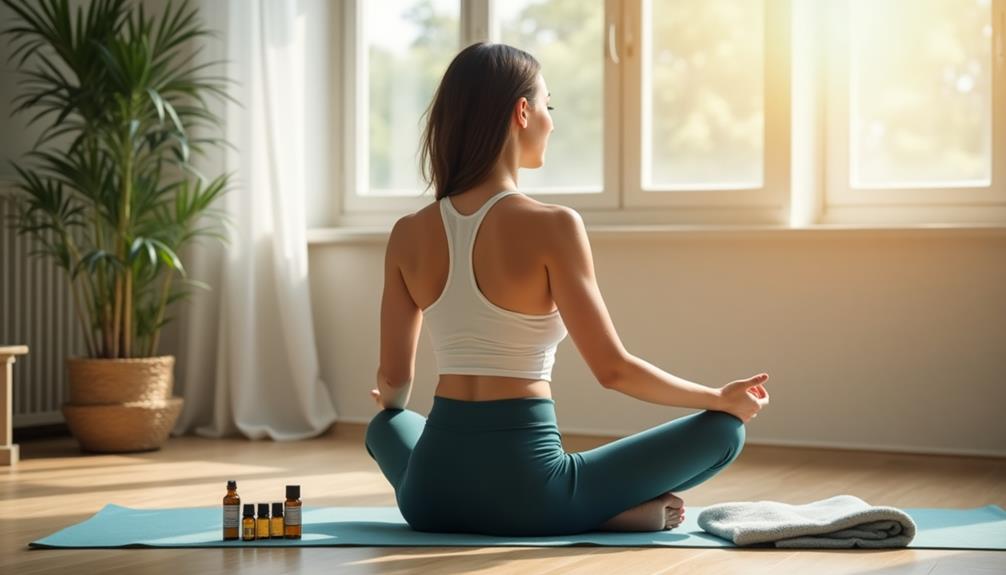
Once you've created the perfect environment for relaxation, it's time to explore self-massage techniques that can help alleviate tension and promote recovery. Start with your hands; apply gentle pressure using your fingers and palms. Focus on areas where you feel tightness. Use circular motions to warm up the muscles, then apply deeper pressure if it feels comfortable. For enhanced cooling relief during your massage, consider using a cooling towel to reduce surface temperature and soothe sore muscles.
Next, try using a massage ball or foam roller. Position it under your tight muscle groups and roll it gently, allowing the pressure to release knots. Don't forget to breathe deeply throughout the process; it helps enhance relaxation.
Targeting Specific Muscle Groups

Many people find that targeting specific muscle groups during recovery massage can greatly enhance relief and promote healing. By focusing on the areas that need the most attention, you can improve circulation and reduce muscle tension.
Here's a simple guide to help you target key muscle groups effectively:
| Muscle Group | Techniques |
|---|---|
| Neck | Gentle kneading |
| Shoulders | Circular motions |
| Lower Back | Palm pressing |
| Hamstrings | Stretch and press |
Start with light pressure, gradually increasing it based on your comfort level. Remember, consistency is key! Incorporate these techniques regularly, and you'll likely notice improved flexibility and reduced soreness. Enjoy the benefits of a well-targeted recovery massage!
Incorporating Essential Oils
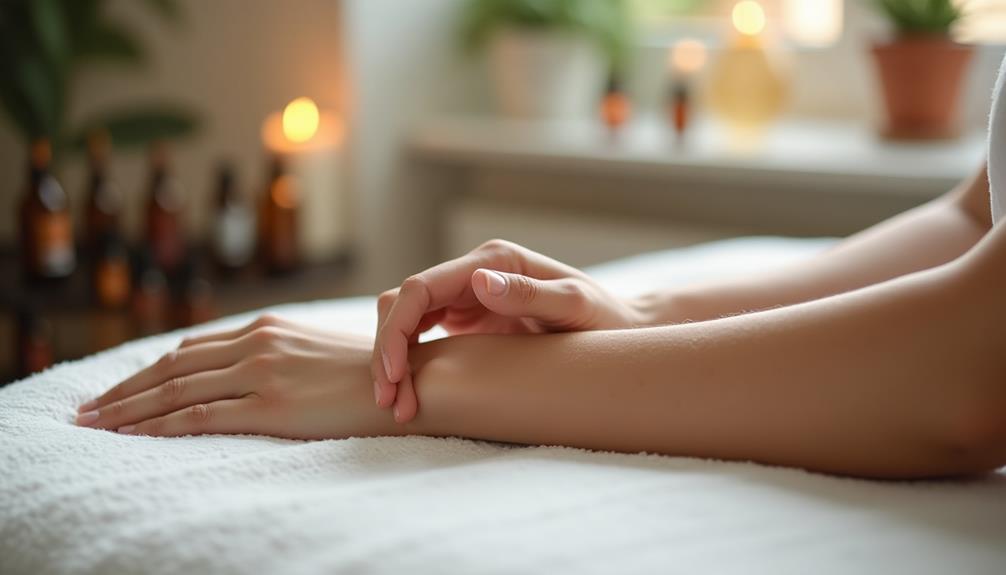
To use essential oils, dilute a few drops in a carrier oil, like coconut or almond oil, to prevent skin irritation. Apply this mixture during your massage, focusing on areas that need extra attention. For enhanced relaxation and better sleep, consider using a sleep-focused essential oil blend in your massage routine. These specially formulated oils can promote deeper rest and recovery.
Remember to test for allergies before using new oils. You might also consider using a diffuser to fill the room with a calming scent, enhancing your overall experience. By incorporating essential oils, you'll elevate your recovery massage, making it both enjoyable and effective.
Breathing and Relaxation Techniques

How can you enhance your recovery massage experience? Breathing and relaxation techniques play a pivotal role in maximizing the benefits of your massage. Start by finding a comfortable position. Close your eyes and take a deep breath in through your nose, filling your lungs completely. Hold for a moment, then exhale slowly through your mouth. Repeat this for a few minutes.
As you breathe, focus on relaxing each muscle group, starting from your toes and working your way up to your head. Visualize tension melting away with each exhale. You can also try counting your breaths to maintain focus. By integrating these techniques, you'll create a peaceful environment, allowing your body to absorb the massage's restorative effects more effectively.
Post-Massage Care Tips
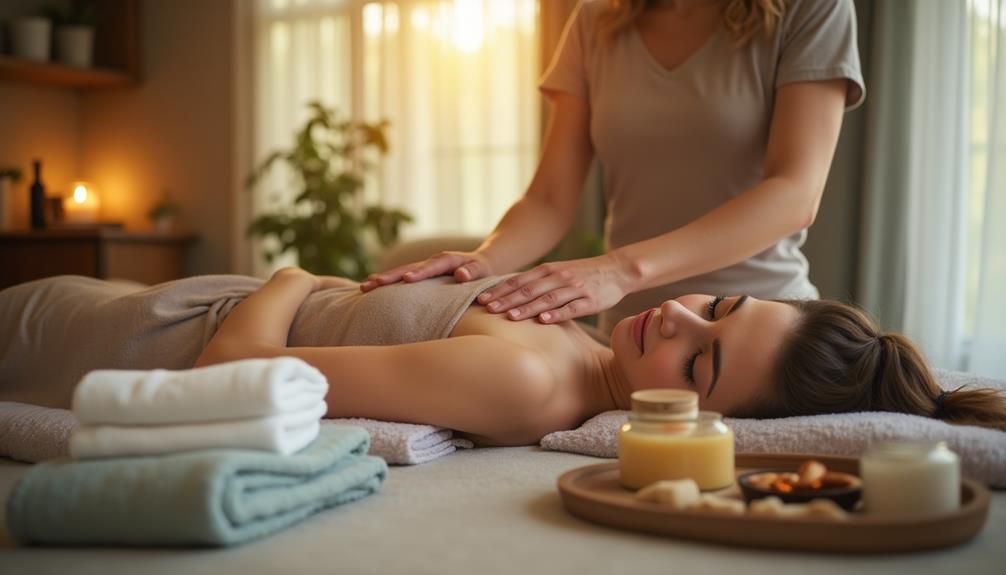
After enjoying a rejuvenating massage, taking care of your body is essential for maximizing its benefits. Here are some post-massage care tips to keep in mind:
Stay Hydrated
Drink plenty of water after your massage. This helps flush out toxins released during the session.
Rest and Relax
Give yourself time to relax. Avoid strenuous activities for the rest of the day, allowing your muscles to recover.
Gentle Stretching
Incorporate light stretching to maintain flexibility. Focus on the areas that received the most attention during your massage.
Warm Bath or Shower
Consider taking a warm bath or shower. It can soothe your muscles and enhance relaxation.
When to Seek Professional Help
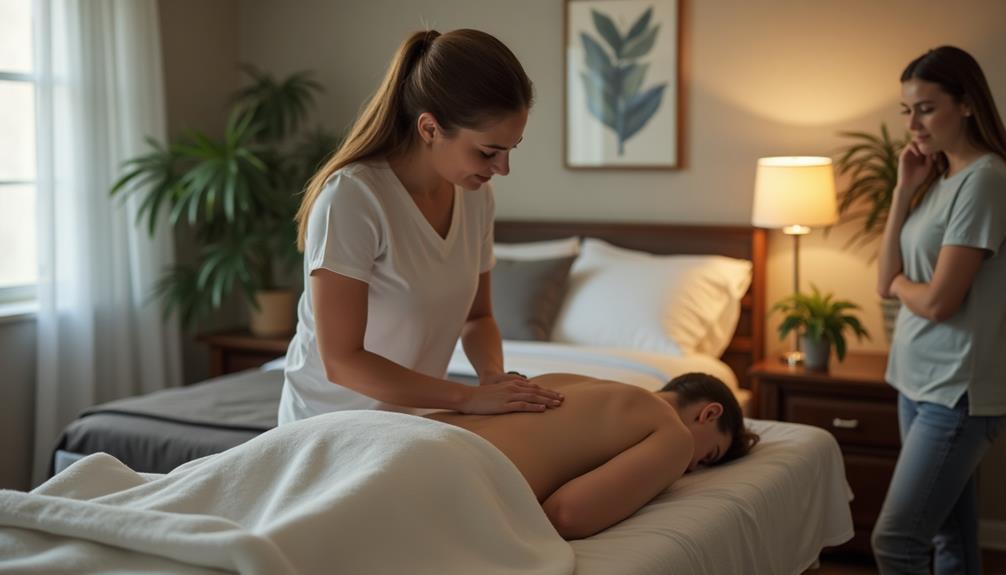
Knowing when to seek professional assistance is crucial for your overall well-being. If you experience persistent pain, discomfort, or tightness that doesn't improve with home massage techniques, it's time to consult a professional. Additionally, if you notice swelling, bruising, or any unusual sensations during or after your massage, don't hesitate to reach out to a healthcare provider.
Another key indicator is if you have a pre-existing medical condition, such as a recent injury, surgery, or chronic illness. In these cases, professional guidance can ensure you're receiving safe and effective treatment. Finally, if you're unsure about any symptoms or how to address them, it's always better to seek help. Your body deserves the best care possible, so don't hesitate to ask for assistance.
Frequently Asked Questions
Can Recovery Massage Help With Anxiety and Stress Relief?
Yes, recovery massage can greatly help with anxiety and stress relief. It promotes relaxation, reduces muscle tension, and stimulates the release of endorphins, which can enhance your overall mood and well-being. You'll feel more balanced.
How Often Should I Perform Recovery Massage at Home?
Imagine sinking into a warm cloud of relaxation. You should perform recovery massage at home a few times a week, adjusting based on how your body feels, to maintain balance and promote well-being effectively.
Are There Any Contraindications for Self-Massage?
Yes, there are contraindications for self-massage. Avoid massaging areas with open wounds, infections, fractures, or severe swelling. If you have certain medical conditions, consult a healthcare professional to guarantee it's safe for you.
Can I Use a Foam Roller Instead of My Hands?
Yes, you can definitely use a foam roller instead of your hands. It targets larger muscle groups effectively, helping relieve tension and improve circulation. Just make sure you use it correctly to avoid injury.
Is Recovery Massage Safe During Pregnancy?
When it comes to recovery massage during pregnancy, you've got to tread lightly. It's generally safe, but consult your healthcare provider first to guarantee you're on the right track and avoid any potential bumps in the road.

